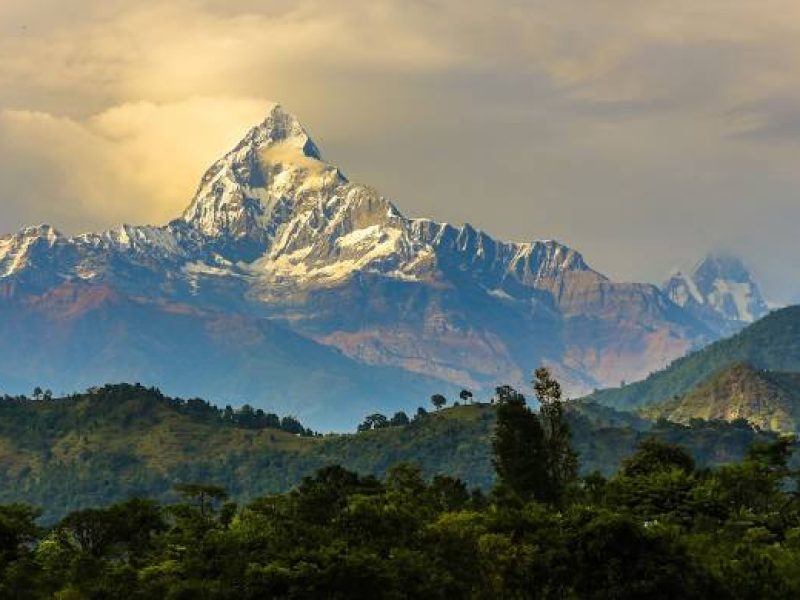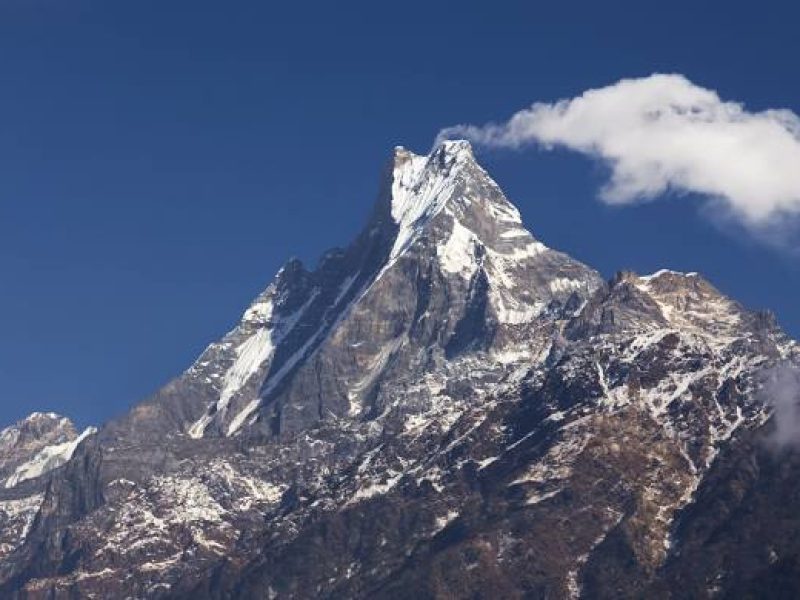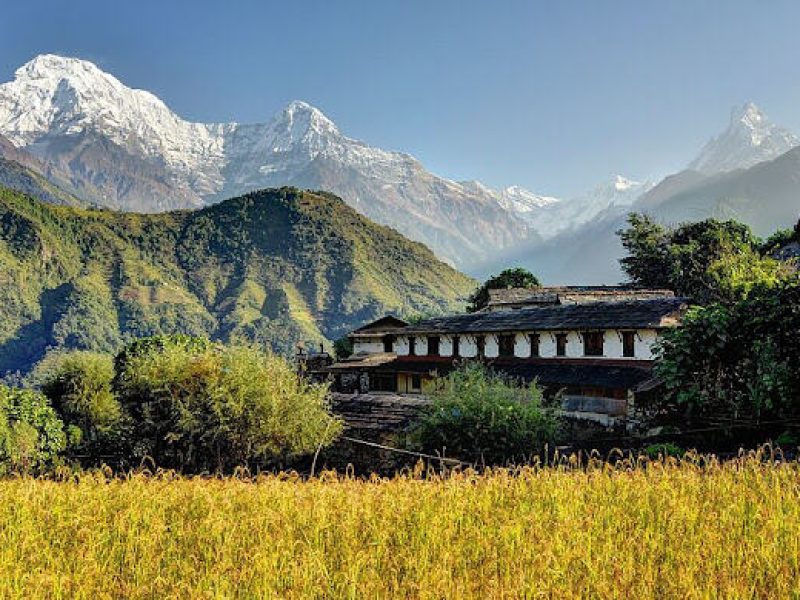Machhapuchhre is a majestic mountain in Nepal known for its double summit that resembles the tail of a fish. At 6,993 meters, it dominates the Pokhara Valley skyline. The mountain holds deep spiritual significance for Nepalese people.
It is believed to be the sacred home of Hindu god Shiva. It symbolizes Nepal’s rich cultural heritage, natural splendor, and spiritual legacy, inspiring awe and reverence.
Due to its religious importance climbing to Machhapuchhre has been prohibited since the 1950s. The surrounding landscape is enchanting with forests, rivers, and villages. Conservation efforts are ongoing, with local communities and conservation organizations working to preserve this natural treasure.
When Is The Best Time To Visit Machhapuchhre Mountains?
The best time to visit Machhapuchhre Mountains and Annapurna region is during spring and autumn. Spring offers mild weather, clear skies, and warm temperatures, with blooming rhododendrons and wildflowers. Trekkers can enjoy comfortable temperatures and cool evenings.

The autumn months of September to November offer clear skies and crisp mountain air, with excellent visibility. The peak trekking season is in autumn with mild temperatures and stable conditions. The clear skies provide an ideal opportunity for photography and capturing the beauty of Machhapuchhre and the Himalayan scenery.
Why Are Machhapuchhre Mountains Forbidden To Climb?
Machhapuchhre mountain in Nepal holds a significant spiritual significance for the Gurung and Magar communities. They believe it is the sacred home of Shiva. Authorities have prohibited climbing to the summit since the 1950s to preserve the mountain’s sanctity and protect its ecosystem and biodiversity. This decision reflects the Nepalese people’s deep respect for their religious and cultural heritage.
Significance Of Machhapuchhre Mountains
Machhapuchhre Mountains in Nepal hold significant spiritual, cultural, and natural importance. It is a sacred mountain in Nepalese mythology and Hindu religious beliefs, believed to be the dwelling place of Shiva.
The mountain’s distinctive double summit, guarded by a celestial fish, is considered a place of divine presence. It symbolizes Nepal’s rich cultural heritage and natural beauty, with its towering peaks and rugged slopes serving as a backdrop for traditional Himalayan life. The mountains also provide habitat for flora and fauna, contributing to scientific research and conservation efforts.
Physical Features Of Machapuchare
Machhapuchhre is also known as Fish Tail Mountain which is a majestic landmark in Nepal’s Annapurna Himalayan Range. It dominates the Pokhara Valley’s skyline with its snow-capped peaks and unique double summit.
The mountain’s rugged slopes, steep cliffs, rocky outcrops, and cascading glaciers create a dramatic landscape. Its pristine glaciers support the diverse ecosystems of the Annapurna region and contribute to its spiritual significance in Nepalese mythology and religious beliefs.
Its physical features have inspired generations of pilgrims and adventurers, making it a symbol of Nepal’s rich cultural heritage and natural splendor.
The Sacred Sanctuary Of Machhapuchhre
The Machhapuchhre Mountain, located in the Annapurna Himalayan Range is a sacred sanctuary of spiritual significance and cultural reverence. The sanctuary is a hub of religious practices and rituals with devotees offering flowers, incense, and prayers.
The Mythical Fish Tail Of Machhapuchhre Mountain
The Mythical Fish Tail is a mythical creature that guards Machhapuchhre Mountain, a sacred place in Hindu mythology. People believe that the mountain’s double summit, resembling a fish’s tail, represents the eternal cycle of life and creation.

Machhapuchhre Adventure And Culture
Machhapuchhre is a mountainous region in the Annapurna region that is a popular destination for adventurers seeking to explore the rugged beauty of the Himalayas. Despite its sacred status, the surrounding area offers numerous opportunities for trekkers, mountaineers and nature enthusiasts to immerse themselves in the stunning landscapes.

Trekkers can enjoy breathtaking views of Machhapuchhre and its neighboring peaks while mountaineers can challenge themselves with technical climbs on nearby peaks. Beyond physical challenges, it offers a rich rainbow of cultural experiences including traditional Himalayan life in indigenous communities. The region is a perfect blend of natural beauty, cultural richness, and adrenaline-fueled excitement.
Preservation And Conservation Efforts Of Machhapuchhre Mountains
The Annapurna region is undergoing significant conservation efforts to protect its ecosystems and cultural heritage. These efforts involve local communities, governmental agencies and non-profit organizations focusing on sustainable tourism practices, waste management, responsible camping and controlled trekking routes.
Community-based conservation initiatives involve local communities in decision-making processes, promoting a sense of ownership and stewardship over the land. Biodiversity conservation is another key aspect, with protected areas and wildlife reserves established to protect vulnerable species.
Educational outreach programs raise awareness about conservation and sustainable living practices, fostering a culture of responsibility. These efforts aim to ensure the region’s long-term health and vitality for future generations.
Conclusion
In conclusion, Machhapuchhre Mountains in Nepal is a symbol of Nepal’s rich cultural heritage, natural beauty and spiritual significance. With towering peaks, pristine wilderness, and rich traditions, they attract adventurers, pilgrims, and nature enthusiasts. The mystical allure of the Fish Tail summit and its sacred sanctuary evoke wonder and reverence.
The mountains offer trekking routes, mountaineering opportunities, and cultural experiences, showcasing the diversity of the Himalayan landscape. Conservation efforts are crucial to preserve the mountains’ ecological integrity and cultural heritage, ensuring their preservation for future generations.
Frequently Asked Questions (FAQs)
1.What is Machhapuchhre Mountain?
Machhapuchhre Mountain is a prominent peak in the Annapurna Himalayan Range of Nepal. Its distinctive double summit, resembling the tail of a fish, has earned it renown, boasting an elevation of 6,993 meters.
2.Why is Machhapuchhre considered as a sacred?
Machhapuchhre holds deep spiritual significance for the local Gurung and Magar communities of Nepal. Since the 1950s, authorities have prohibited climbing to the summit of Machhapuchhre due to its religious importance as the sacred abode of the Hindu god Shiva, guarded by a celestial fish.
3.Can I climb Machhapuchhre Mountain?
4.What trekking routes are available in the Machhapuchhre area?
The Annapurna region offers a variety of trekking routes, including the Annapurna Circuit, Annapurna Base Camp Trek, and Mardi Himal Trek, among others. These routes traverse through diverse terrain, including lush forests, alpine meadows, and high mountain passes.
5.What is the best time to visit Machhapuchhre Mountains?
The best time to visit Machhapuchhre Mountains and the Annapurna region is during the spring (March to May) and autumn (September to November) seasons. During these times, the weather is generally clear, and the views of the mountains are stunning.
6.Are there any conservation efforts in place to protect Machhapuchhre Mountains?
Yes, there are ongoing conservation efforts aimed at preserving the natural beauty and cultural heritage of Machhapuchhre Mountains and the Annapurna region. These efforts include promoting sustainable tourism practices, empowering local communities, and conserving biodiversity.
7.What is the significance of the Fish Tail summit of Machhapuchhre?
The Fish Tail summit of Machhapuchhre is a distinctive feature that lends the mountain its name. Believers hold that it represents the sacred homeof the god Shiva, guarded by the tail of a celestial fish. This unique summit adds to the mystique and allure of Machhapuchhre Mountains.
Introducing Trek Me Nepal: Embark on Unforgettable Journeys
At Trek Me Nepal, every step you take should be an adventure, every breath you inhale should be filled with the essence of nature, and every heartbeat should resonate with the rhythm of the mountains. We are a passionate team of explorers committed to crafting unforgettable trekking experiences in the breathtaking landscapes of Nepal.

Comment (0)